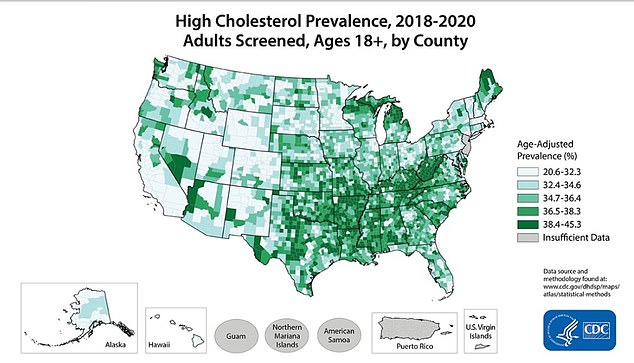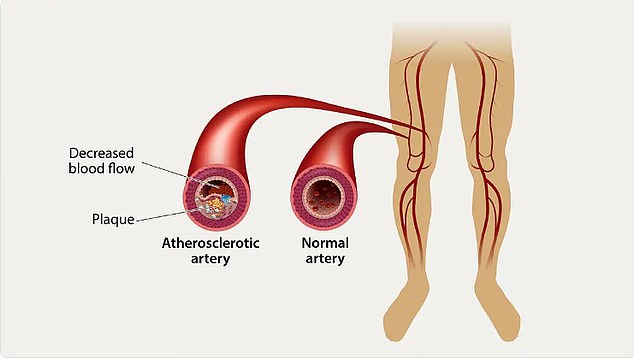Subtle signs in your legs that indicate high cholesterol and heart attack risk
An estimated 25 million Americans suffer from high cholesterol, which increases the risk of heart attack and stroke.
But because many do not get a blood test, four in ten people are completely unaware that they have it.
Doctors are raising awareness about a sign you can look out for in your daily life that could alert you to your risk – and it affects the legs.
The most common symptom, according to the CDC, is subtle leg pain during movement, as well as cold, numb toes and loss of pulse in the legs.
Cholesterol is a waxy, fatty substance that is necessary for our bodies to function, but when someone has high cholesterol, the sticky molecules can build up in the blood vessels, restricting blood flow.
Your Legs Can Be a Window to Your Health (Stock)

The map shows the concentrations of provinces with the highest cholesterol prevalence. Health officials typically advise people to limit their intake of fatty foods, which can affect the amount of cholesterol the body produces
People with high cholesterol sometimes develop a condition called peripheral artery disease (PAD), in which the small blood vessels in the legs or arms become blocked.
Within five years of being diagnosed with PAD, 20 percent of patients will have a heart attack or stroke.
Dr. Amy Pollak, a cardiologist at the Mayo Clinic, said, “We need to ask questions about symptoms, treat these patients with aggressive medical therapy and monitor them more closely.”
This, according to Dr. Pollak, could be critical in reducing the number of people with heart disease, which is currently the leading cause of death in the US.
The most common symptom, which affects 60 percent of people with PAD, is an aching, cramping, or aching feeling in the arms or legs while moving or exercising, which ends when you sit down to rest.
Television personality Howie Mandel, 68, has been open about his battle with high cholesterol, hoping to raise awareness about the condition.
He said that, like many people, he ignored doctors’ warnings to control his cholesterol when he was younger.
Now he realizes how dangerous that is, and he urges people to manage their condition with medication and diet.
Mandel said, “The bad cholesterol is sticky. So you cannot say: ‘I will have a heart problem within a few weeks’, but you can say within a few seconds.’
High cholesterol is incredibly common – and can be caused by genetics or poor diet and exercise choices. Eating foods high in animal fats, such as red meat, dairy and fried foods, can worsen cholesterol.
You can’t feel high cholesterol on its own, which means people often shrug it off, but over a lifetime, elevated levels of this fatty substance can start to affect your body.
One of the first changes some may see happening in the legs, with PAD.
In addition to pain when walking, other signs of PAD include muscle weakness, hair loss, shiny skin, skin that is cool to the touch, decreased or absent pulse in the feet, sores that do not heal on the legs, and cold, numb toes.
People who smoke, have high blood pressure, have diabetes, or are obese are all at greater risk of developing PAD. After age 60, the risk of developing PAD increases.

Howie Mandel started a campaign to raise awareness about the risks of high cholesterol called Take Cholesterol to the Heart

Cholesterol can build up in the small blood vessels in the legs, causing pain when walking, numbness, hair loss, shiny skin and ulcers, all signs of PAD. Catching and diagnosing PAD can help a person avoid heart disease, stroke or amputation in the future, Dr. Pollak said.
In the five years following a PAD diagnosis, approximately one-third will die and 20 percent will have a heart attack or stroke. according to Mayo Clinic.
If left undiagnosed, people with PAD are at greater risk for limb loss because the loss of circulation can cause tissue to die, the study said. American Heart Association.
Treatments include both lifestyle changes, such as controlling blood sugar levels, and medical changes, such as starting blood thinners or statins.
Statins are medications that can lower the amount of cholesterol in your bloodstream.
Additionally, to prevent PAD, the CDC recommends regular cardio exercises to keep blood pumping more actively through the circulatory system.
Spreading awareness about this condition, and the risks of high cholesterol in general, is critical to preventing an increase in the number of people with heart disease in the future as America’s population continues to age, Pollak said.
Dr. Pollak said, “As a greater percentage of the U.S. population ages in the coming decades, progressive cardiovascular diseases such as PAD will be relevant to even more people.”
